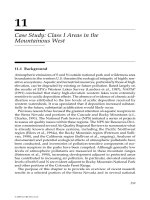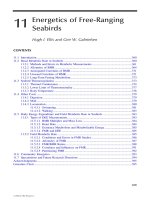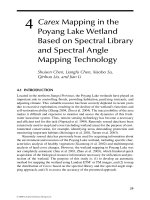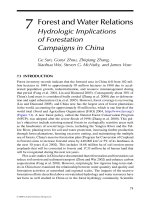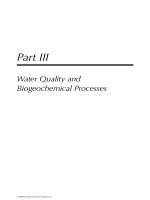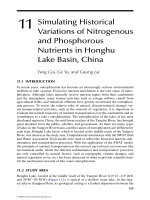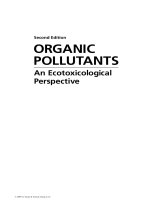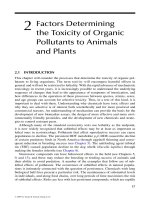ORGANIC POLLUTANTS: An Ecotoxicological Perspective - Chapter 11 pot
Bạn đang xem bản rút gọn của tài liệu. Xem và tải ngay bản đầy đủ của tài liệu tại đây (346.48 KB, 11 trang )
219
11
Anticoagulant
Rodenticides
11.1 BACKGROUND
Warfarin, which was introduced to the market in the late 1940s, was the rst of a series
of anticoagulant rodenticides (ARs) related in structure to dicoumarol (Figure 11.1;
Buckle and Smith 1994; Meehan 1986). All of them are toxic because they act as
anticoagulants, extending the clotting time of blood and thus causing hemorrhaging.
The anticoagulant properties of naturally occurring dicoumarol were discovered in
the United States early in the 20th century, when it was found to be the causal agent
in cases of fatal hemorrhaging of cattle fed with spoiled clover. Subsequently, it was
discovered that dicoumarol and rodenticides related to it have anticoagulant action
because they act as vitamin K antagonists.
For some years, warfarin was by far the most widely used rodenticide of this
type. In time, however, strains of rats resistant to warfarin began to appear, and
the compound became ineffective in some areas where it had been regularly used.
Resistance was overcome, at least in the short term, by a second generation of ARs
sometimes called superwarfarins. Examples include brodifacoum, difenacoum, o-
coumafen, and bromodiolone. The superwarfarins are more hydrophobic, persistent,
and toxic than warfarin itself. They have usually been effective in overcoming resis-
tance to warfarin and, consequently, have come into more widespread use with time.
Although knowledge about their environmental fate and effects is at present very
limited, enough is known to raise questions about the risks that might be associated
with their increasing use. The combination of persistence with very high vertebrate
toxicity has set the alarm bells ringing. The ensuing account will be principally con-
cerned with the second-generation rodenticides.
11.2 CHEMICAL PROPERTIES
The formulas of some ARs are given in Figure 11.1, where it can be seen that they
have some structural resemblance to both dicoumarol and vitamin K in its quinone
form. All possess quinone rings linked to unsubstituted phenyl rings. The phenyl
rings of the rodenticides confer hydrophobicity, especially in the relatively large and
complex molecules of brodifacoum and ocoumafen. The chemical properties of
some ARs are given in Table 11.1
All the compounds listed in Table 11.1 are solids. Flocoumafen and brodifa-
coum have particularly low vapor pressures. The hydrophobicity of brodifacoum
and ocoumafen is reected in their low water solubility. It should be remembered,
© 2009 by Taylor & Francis Group, LLC
220 Organic Pollutants: An Ecotoxicological Perspective, Second Edition
TABLE 11.1
Properties of Anticoagulant Rodenticides
Compound
Water Solubility
(mg/L) log K
ow
Vapor Pressure
(mPa)
Warfarin 17 1.5 × 10
−3
Flocoumafen 1.1 4.7 1.3 × 10
−7
Brodifacoum 0.24 (pH 7.4) 8.5 << 1 × 10
−3
Difenacoum 2.5 (pH 7.3)
O
O
CH
2
Dicoumarol
O
O
OH OH
OH
OH
O
O
O
O
O
CH
2
Warfarin
C O
CH
3
CF
3
OH
O
O
O
O
Vitamin K
(quinone form)
Brodifacoum Flocoumafen
Br
CH
3
R = phytyl (vitamin K
i
) or
a polyisoprenoid in the
case of menaquinones
R
FIGURE 11.1 Anticoagulant rodenticides.
© 2009 by Taylor & Francis Group, LLC
Anticoagulant Rodenticides 221
however, that because they possess ionizable hydroxyl groups, water solubility is
pH dependent. With brodifacoum, for example, water solubilities are 3.8 × 10
−3
and
10 mg/L at pH values of 5.2 and 9.3, respectively. An increase in pH encourages
some ionization, and solubility increases accordingly.
11.3 METABOLISM OF ANTICOAGULANT RODENTICIDES
Metabolism has been studied in more detail for warfarin than for other related
rodenticides. The metabolism of warfarin appears to be essentially similar to that
of related compounds, and will be taken as a model for the group. Two main types
of primary metabolic attack have been recognized: (1) monooxygenase attack upon
diverse positions on the molecule to yield hydroxy metabolites and (2) conjugation
of the hydroxyl group to yield glucuronides. The hydroxy metabolites formed by
monooxygenase attack are also subject to conjugation in the case of warfarin and
related ARs. More than one form of P450 is involved in warfarin metabolism. Hepatic
cytochrome P450 2 C9 appears to be the most important of them, and is involved
in warfarin hydroxylation in both rats and humans (Aithal et al. 1999; Wadelius
and Pirmohamed 2007). Other forms, including CYP2e1, CYP2c13, CYP2A2, and
CYP3a3, have been implicated in resistance mechanisms to ARs (see Section 11.6).
In a study of metabolism of 14C-ocoumafen by the Japanese quail (Huckle et
al. 1989), biotransformation was extensive and rapid, with eight metabolites detected
in excreta. The elimination of radioactivity from the liver of Japanese quail was
biphasic (Figure 11.2). After an initial period of rapid elimination, there followed a
10
–1
μg Flocoumafen Equivalents/g
1
0 10203040 5060
Time (days)
70 8090100 110 120
10
FIGURE 11.2 Loss of ocoumafen residues from quail liver. Depletion of radioactivity from
Japanese quail after a single oral dose (14 mg/kg). Data are presented as microgram equiva-
lents of f per gram of tissue and are mean values of two animals. Data collected at day 7 and
day 12 were from four animals and three animals, respectively (from Huckle et al. 1989).
© 2009 by Taylor & Francis Group, LLC
222 Organic Pollutants: An Ecotoxicological Perspective, Second Edition
period of slow exponential decline, indicating a half-life of more than 100 days. Slow
elimination in the second phase has also been demonstrated in rodents and attributed
to very strong binding to one or more proteins of the hepatic endoplasmic reticulum,
which greatly reduces the availability of ocoumafen to enzymes that metabolize it.
Other highly toxic superwarfarins, such as brodifacoum and difenacoum, also show
very slow “second phase” elimination from the liver, associated with strong protein
binding. Depending on compound and species, <2μg/g (2 ppm by weight) of the
residue of superwarfarins can be strongly bound in the liver. Most other tissues show
less capacity for protein binding.
Some of the strong protein binding in liver is to the target site of the rodenticide,
the reductase of vitamin K 2,3-epoxide (see Section 11.2.3). There is also evidence
that ocoumafen can bind strongly to cyto P450 1A1. In the Japanese quail, the
binding of ocoumafen to hepatic microsomes was linked to strong inhibition of
EROD-ase activity, both in vivo and in vitro (Fergusson 1994). Strong binding to two
sites in the liver, the vitamin K binding site and cyto P450 1A1, could explain the
biphasic elimination of ocoumafen by this species (Figure 11.2). Initial relatively
rapid elimination could have been mainly of rodenticide released from the site that
was binding it more weakly, whereas the later much slower release could have been
from the site where binding was strongest.
The marked persistence of the readily biodegradable superwarfarins in liver is
something of a paradox. Ready biodegradibility does not guarantee a short half-life.
Superwarfarins are much more biodegradable than refractory pollutants, such as
pp-DDE, dioxin, and higher chlorinated PCBs. Yet they can still be highly persistent
at low concentrations in certain tissues because tenacious binding ensures that they
are virtually unavailable to the P450s that can degrade them. Such long-term storage
brings the risk of long-term toxic effects in individuals and in food chains.
11.4 ENVIRONMENTAL FATE
Two contrasting uses of ARs have caused environmental problems. First, their wide-
spread employment on farms and in areas of human habitation to control rodents;
second, their use to control rats and mammalian predators, which pose a threat to
other species in conserved areas (Howald et al. 1999; Eason et al. 2002). These two
scenarios will now be considered in the order given.
When used on farms or in inhabited areas, warfarin and related rodenticides are
usually incorporated into baits that are placed in locations where they will be found
by rats, mice, and certain other vertebrate pests. There is a potential risk that baits
will be eaten by pets, farm animals, and other nontarget species. To guard against
this, baits are often made inaccessible to vertebrates other than the target species. For
example, baits may be put in short lengths of piping, wide enough for rats and mice
to enter, but narrow enough to exclude cats and dogs. In Western Europe, warfarin is
used both inside and outside of farm buildings. The use of more toxic rodenticides,
such as brodifacoum and ocoumafen, is often restricted to the interior of buildings,
to reduce the risk to nontarget species.
When used in this controlled way, there is still concern that these compounds
may be transferred via rodents to terrestrial predators and scavengers that feed
© 2009 by Taylor & Francis Group, LLC
Anticoagulant Rodenticides 223
upon them. Avian species at risk include members of the crow family, such as raven
(Corvus corax), magpie (Pica pica), carrion crow (Corvus corone), and rook (Corvus
frugilegus); owls, such as barn owl (Tyto alba) and tawny owl (Strix aluca); and large
predators that are also carrion feeders, such as buzzard (Buteo buteo) and red kite
(Milvus milvus). Mammalian predators, such as stoats (Mustela erminea), weasels
(Mustela nivalis), and polecats (Mustela putorius), are also vulnerable (McDonald et
al. 1998; Shore et al. 1999).
A major concern about ARs is the possibility of their being passed from rodents
and other target species to other vertebrates higher in the food chain. This is particu-
larly the case with second-generation ARs, such as brodifacoum and ocoumaphen,
which have long half-lives in the liver, half-lives that can exceed 100 days during the
later stages of elimination. Thus, owls and other predators may acquire these com-
pounds from their live prey. Also, scavengers, such as corvids and kites (Milvus spp.),
may feed on the carcasses of animals that have been poisoned by rodenticides.
Several factors contribute to the risk that nontarget predators and scavengers will
acquire substantial doses of these compounds in the eld. First, animals that have
consumed lethal doses of ARs survive for 5 days or more before they die of hemor-
rhaging. Thus, they may continue feeding during this period, building up residues in
the body that exceed the levels needed to lethally poison them. Second, some resis-
tant strains of rodents can tolerate relatively high levels of rodenticide and so act as
more efcient vectors of the pesticide than susceptible strains. Third, in the case of
predation, rodents, etc., which are in the later stages of poisoning are likely be more
vulnerable than normal healthy individuals; in other words, there may be selective
predation upon the most contaminated members of the prey population.
A number of reports have established the presence of rodenticides in predators and
scavengers found dead in the eld (see, for example, reports of U.K. Wildlife Incident
Investigation Scheme [WIIS]). Brodifacoum, difenacoum, bromodiolone, and o-
coumafen have all been found, albeit at low levels in most cases (<1 ppm in liver).
Sometimes, more than one type of rodenticide has been found in one individual. The
toxicological signicance of these residues will be discussed in Section 11.5.
One study conducted in Britain between 1983 and 1989 was of barn owls found
dead in the eld; 10% of the sample of 145 birds contained anticoagulant rodenticide
residues in their livers, and difenacoum and brodifacoum were prominent among
them (Newton et al. 1990). In another study, barn owls were fed rats that had been
dosed with ocoumafen. It was found that a substantial proportion of the rodenticide
ingested by owls was eliminated in pellets (Eadsforth et al. 1991). The authors sug-
gest that exposure of owls to rodenticides in the eld may be monitored by analysis
of pellets dropped at roosts or regular perching places.
In contrast to the controlled use of these compounds in the neighborhood of
farms and human habitation, they have sometimes been used in a less controlled
way against rodents and vertebrate predators, which causes problems in conserved
areas. In a number of conserved islands in New Zealand, for example, bait contain-
ing brodiphacoum has been used for rodent control, both at bait stations and by aerial
distribution (Eason et al. 2002). In the latter case, poisoned bait is freely available,
and herbivores and omnivores, as well as predators and scavengers are at high risk.
This problem will be discussed further in Section 11.6.
© 2009 by Taylor & Francis Group, LLC
224 Organic Pollutants: An Ecotoxicological Perspective, Second Edition
11.5 TOXICITY
The mode of action of warfarin and related rodenticides is illustrated in Figure 11.3.
Vitamin K in its reduced hydroquinone form is a cofactor for a carboxylase located
in the rough endoplasmic reticulum of hepatocytes. It is converted into an epox-
ide when it participates in the conversion of glutamate residues of certain proteins
to gamma-carboxy-glutamate (gla). The regeneration of the hydroquinone form of
vitamin K from the 2,3-epoxide is dependent on the function of a reductase. When
ARs bind to the reductase, they prevent the conversion of the epoxide to the quinone.
They also inhibit the subsequent reduction of the quinone to the hydroquinone. Thus,
ARs can prevent the cyclic regeneration of the hydroquinone form so that carboxyla-
tion of glutamate slows down or ceases. A gene has now been cloned that encodes
for the subunit of vitamin K 2,3-epoxide reductase to which warfarin and other cou-
marin-related anticoagulants bind (Robertson 2004; Goodstadt and Ponting 2004).
This component is termed the vitamin K epoxide reductase subunit 1 (VKORC1).
VKORC1 is now known to belong to a family of homologues that are found in verte-
brates, arthropods, bacteria, and plants.
In the case of prothrombin and related clotting factors, interruption of the vitamin
K cycle leads to the production of nonfunctional, undercarboxylated proteins, which
are duly exported from hepatocytes into blood (Thijssen 1995). They are nonfunc-
tional because there is a requirement for the additional carboxyl residues in the clot-
ting process. Ionized carboxyl groups can establish links with negatively charged
sites on neighboring phospholipid molecules of cell surfaces via calcium bridges,
R
O
O
OH
OH
Quinone
reductase
Glutamate
residue
Protein
HCH
R
OH
OH
R
SH – SH
S – S
SH – SHI
S – S
O
R
O
O
R
Epoxidase
Epoxide
reductase
NAD(P)
+
Quinone
reductase
Inhibition by
anticoagulant
rodenticides
NAD(P)H
OH
O
Carboxylase
COOH
NAD(P)
O
2
O
2
O
2
CO
2
NAD(P)H
GLA
HC – COOH
COOH
FIGURE 11.3 Action of warfarin and related rodenticides on the vitamin K cycle.
© 2009 by Taylor & Francis Group, LLC
Anticoagulant Rodenticides 225
and these links are necessary for the formation of blood clots. Because clotting pro-
teins turn over slowly (half-life of prothrombin in the rat is about 10 h), several days
will elapse after inhibition of the vitamin K cycle before the level of functional clot-
ting proteins is sufciently low for severe hemorrhaging to occur. Typically, rats and
mice begin to die from hemorrhaging 5 days or more after exposure to ARs. Owing
to the strong afnity of superwarfarins for the reductase, the available binding sites
may be progressively occupied by ARs over a period of weeks or even months of
continuing exposure to low levels of the compounds. Evidently, all the superwarfa-
rins bind to the same site, and it is to be expected that by so doing they will have an
additive toxic effect. What is unclear, and can make interpretation of residue data
difcult, is what degree of occupancy of the reductase binding sites by ARs will lead
to serious hemorrhaging. Some individuals appear perfectly healthy when carrying
liver residues high enough to cause hemorrhaging in others.
Because of the difculties of interpretation of residue data, it is important to have
other evidence to aid the recognition of toxic effects in the eld. Hemorrhaging is usu-
ally easy to identify in a postmortem examination if carcasses are in reasonable condi-
tion. If early toxic effects are to be identied in live vertebrates, however, a biomarker
assay is needed (Fergusson 1994). The detection of undercarboxylated gla proteins in
blood has already been used to monitor human exposure to warfarin and other ARs
(Knapen et al. 1993). The development of such an assay, for example, an ELISA assay,
which could be used in predators and scavengers exposed to rodenticides in the eld,
has obvious attractions. It should then be possible to establish when levels of exposure
in the eld are high enough to begin to inhibit the vitamin K cycle, and increase the
blood level of undercarboxylated clotting proteins. Toxic effects could be identied at
an early stage before the occurrence of deaths due to hemorrhaging.
Because of the delay in the appearance of hemorrhaging following exposure to
warfarin and related ARs, a suitable interval must elapse between exposure of exper-
imental animals to the chemical and the assessment of mortality in toxicity testing.
Typically, this period is at least 5 days. Some values of acute oral LD50 of rodenti-
cides to vertebrates are given in Table 11.2.
Looking at the data overall, brodifacoum and ocoumafen are more toxic than
warfarin to mammals. However, toxicity of the two former compounds to birds var-
ies considerably between species. On available evidence, the galliform birds chicken
(Gallus domesticus) and Japanese quail (Coturnix coturnix japonica) are much less
sensitive to ocoumafen than are mammals. The chicken is less sensitive to brodi-
facoum than mammals. The mallard duck (Anas platyrhynchus), however, is just as
sensitive as mammals to brodifacoum, whereas studies with the barn owl (Tyto alba)
indicate that this species has comparable sensitivity to the rat or mouse. In toxicity
tests on 13 species of birds native to New Zealand, LD50s for brodifacoum ranged
from 0.95 mg/kg in the pukeko to >20 mg/kg in the Paradise shelduck (Eason et
al. 2002). Thus, it appears that ocoumafen and brodifacoum are generally more
toxic to mammals than to birds, although some birds are of comparable sensitivity
to mammals.
Newton et al. (1990) fed mice containing brodifacoum to barn owls, and estimated
that birds lethally poisoned by the rodenticide (n = 4) had consumed 0.150–0.182
mg/kg of the compound. The birds died within 6–17 days of receiving a single dose
© 2009 by Taylor & Francis Group, LLC
226 Organic Pollutants: An Ecotoxicological Perspective, Second Edition
of brodifacoum and contained 0.63–1.25 mg/kg of the rodenticide in the liver. In this
study, owls were also dosed with difenacoum, which was found to be less toxic than
brodifacoum.
11.6 ECOLOGICAL EFFECTS
11.6.1 POISONING INCIDENTS IN THE FIELD
A number of studies have shown that predatory and scavenging birds can acquire
liver residues of second-generation ARs when these compounds are used on farmland
(Newton et al. 1990; Annual Reports of the U.K. WIIS), and that the levels are some-
times high enough to cause death by hemorrhaging (Merson et al. 1984). In a eld
trial with brodifacoum conducted in Virginia, United States, ve screech owls (Otus
asio) found dead 5–37 days posttreatment contained 0.4–0.8 μg/g of the rodenticide in
liver (Hegdal and Colvin 1988). These residues are of similar magnitude to the levels
found in poisoned barn owls in the study mentioned earlier.
When ARs have been used to control rodents and vertebrate predators in con-
served areas, there have been instances of both primary and secondary poisoning.
In New Zealand, such incidents have been observed on islands where bait treated
with brodifacoum has been used. Casualties have included native raptors, such as the
Australasian harrier (Circus approximans) and morepork (Ninox novaeseelaniae), as
well as other species, such as the pukeko, Western weka (Galliralus australis), and
TABLE 11.2
Acute Oral LD50 Values for Some Anticoagulant Rodenticides
Compound Species
Acute Oral LD50
(mg/kg)
Warfarin Rat 1
Warfarin Pig 1
Brodifacoum Rat (male) 27
Bridifacoum Rabbit (male) 0.3
Brodifacoum Mouse (male) 0.4
Brodifacoum Chicken 4.5
Brodifacoum Mallard duck 0.31
Brodifacoum Pukeko
a
0.95
Brodifacoum Paradise Shelduck
b
> 20
Flocoumafen Rat 0.25
Flocoumafen Mouse 0.8
Flocoumafen Chicken > 100
Flocoumafen Japanese quail > 300
Flocoumafen Mallard duck c 24
a
Porphyrio p melanotus
b
Tadorna variegata
Source: Data from Tomlin (1997) and Eason et al. (2002).
© 2009 by Taylor & Francis Group, LLC
Anticoagulant Rodenticides 227
southern black-backed gull (Larus dominicanus) (Eason and Spurr 1995; Eason et
al. 2002). Three indigenous species of birds were found to be severely reduced in
numbers immediately after use of brodifacoum on a number of islands. These were
the Western weka, pukeko, and Stewart Island weka (Galliralis a. scotti). In one
case, the entire island population of Western wekas was wiped out by primary and
secondary poisoning following the application of brodifacoum (Eason and Spurr
1995). In another study, on Langara Island, British Columbia, Canada, ravens died
of brodifacoum poisoning during a rat control program (Howald et al. 1999). They
had acquired the rodenticide both directly from bait and indirectly by predating or
scavenging poisoned rats. Postmortem examination established that the birds had
died of severe hemorrhaging, and contained 0.98–2.52 mg/kg brodifacoum in the
liver, mean value 1.35 mg/kg (n = 13).
As discussed earlier, a problem with these eld incidents is that the low levels of
rodenticides found in many of the poisoned birds are of similar magnitude to those
in birds surviving exposure. A low residue level may signify everything or noth-
ing. Additional evidence is needed to establish that the concentrations of rodenticide
present in the livers of birds or mammals found in the eld are sufcient to have
caused death, for example, the presence of hemorrhaging in the carcasses.
The demonstration that owls as well as other predators and scavengers can acquire
lethal doses of superwarfarins in the eld following normal patterns of use has raised
questions about the possibility of their causing widespread population declines. In
one case reported in Malaysia, a population decline of owls was related to the use of
superwarfarins (see Newton et al. 1990). In Britain, however, a widespread decline of
the barn owl population during the 1980s could not be explained in terms of rodenti-
cide use. Only a small proportion (2%) of the barn owls found dead during the period
1983–1989 contained residues of brodifacoum+difenacoum of 0.1 ppm or above in
the liver. Thus, no more than 2% of the dead owls contained residues of rodenticides
high enough to suggest poisoning. However, it should also be pointed out that the use
of superwarfarins was restricted at the time of the survey. The recommended use of
brodifacoum, for example, was (and still is) restricted to the interior of buildings.
Superwarfarins have been used mainly in areas where resistance has developed to
warfarin. The critical question is whether increasing use of superwarfarins would
bring a signicant risk to owls and other species exposed to them. During the 1990s,
cases have been reported of red kites and other birds of prey dying as a consequence
of poisoning by superwarfarins (see reports of WIIS). This is a controversial issue
because red kites have been reintroduced into England in recent years. The popula-
tion is still small but growing. It has been suggested that mortality due to rodenticide
poisoning may prevent the reestablishment of the species in certain areas of the
country where these chemicals are coming to be more widely used.
In summary, there is as yet no clear evidence that superwarfarins have caused any
widespread declines of predators and scavengers that feed on rodents. However, the
persistence and very high cumulative toxicity of these compounds suggest that they
could pose a serious hazard to such species if they were to be more widely used. The
situation needs to be kept under close review.
© 2009 by Taylor & Francis Group, LLC
228 Organic Pollutants: An Ecotoxicological Perspective, Second Edition
11.6. 2 POPULATION GENETICS
Resistance to warfarin has developed in populations of rats after repeated expo-
sure to the rodenticide (Thijssen 1995). One resistant strain discovered in Wales
was found to have a much reduced capacity to bind warfarin to liver microsomes,
in comparison to susceptible rats. Resistance was due to a gene that encoded for a
form of vitamin K epoxide reductase that was far less sensitive to warfarin inhibition
than the form in susceptible rats. Another resistant strain, which arose in the area of
Glasgow, was found to differ from the resistant Welsh strain. Resistance was again
due to an altered form of vitamin K epoxide reductase. However, the strain from the
Glasgow area contained a form of the enzyme that bound warfarin just as strongly
as that from susceptible rats. The difference was that the binding was readily revers-
ible (Thijssen 1995). Recent work has established that a number of mutations of the
VKORC1 of vitamin K epoxide reductase are associated with resistance in rodents
(Pelz et al. 2005). Different mutations of VKOCR1 could explain the contrasting
warfarin-binding properties in the two resistant strains mentioned earlier.
Much of the known resistance to warfarin and related ARs in rodents has been
attributed to mutant forms of vitamin K epoxide reductase, but a few strains show evi-
dence of a metabolic mechanism. For example, a resistant strain of rats from the area
of Andover, United Kingdom, appears to owe its resistance to enhanced detoxication
by a P450-based monooxygenase. It is known that CYP2C9, the principal cytochrome
P450 form concerned with the hydroxylation of warfarin, exists in different forms
with differing catalytic properties. Indeed, there is evidence that it is differences in
these forms that underlie corresponding differences between individual humans in
their sensitivity to this anticoagulant (Aithal et al. 1999). Thus, it seems clear that
some warfarin resistance is due to relatively rapid hydroxylation by monooxygenase.
There is also evidence from a Danish study suggesting that cytochrome-P450-me-
diated detoxication may contribute to bromodiolone resistance in one strain of rats. In
comparison with susceptible rats, resistant ones showed overexpression of the genes
CYP2e1, CYP2c13, CYP3a2, and CYP3a3 (Markussen et al. 2008). Although these
results strongly suggest the involvement of cytochrome P450 forms in conferring resis-
tance, the role of these forms in metabolism of bromodiolone has not been claried.
11.7 SUMMARY
Warfarin and the second-generation superwarfarins are ARs that have a structural
resemblance to dicoumarol and vitamin K. They act as vitamin K antagonists,
thereby retarding or stopping the carboxylation of clotting proteins in the hepatic
endoplasmic reticulum. The buildup of nonfunctional, undercarboxylated clotting
proteins in the blood leads eventually to death by hemorrhaging.
Brodifacoum, difenacoum, ocoumafen, and other superwarfarins bind strongly
to proteins of the hepatic endoplasmic reticulum and consequently have long half-
lives in vertebrates, often exceeding 100 days. Thus, they present a hazard to preda-
tors and scavengers that feed on rodents which have been exposed to superwarfarins.
A number of species of predatory and scavenging birds have died as a consequence
© 2009 by Taylor & Francis Group, LLC
Anticoagulant Rodenticides 229
of secondary poisoning by superwarfarins in eld incidents, and questions are asked
about the long-term risks associated with expanding use of these compounds.
When used to control rodents and predatory mammals in conserved areas, they
have caused both primary and secondary poisoning of nontarget species, sometimes
associated with population declines.
FURTHER READING
There is a shortage of appropriate texts on the ARs. Buckle and Smith (1994) and
Mechin (1986) describe the use of ARs in rodent control. Thijssen (1995) gives a
concise account of mode of action and resistance mechanisms. For effects on nontar-
get species, reference should be made to the individual citations given in the forego-
ing text.
© 2009 by Taylor & Francis Group, LLC
